A Near-Real-Time Operational Live Fuel Moisture Content (LFMC) Product to Support Decision-Making at the National Level
Abstract
1. Introduction
2. Materials and Methods
2.1. LFMC Sampling and Data Processing
2.2. LFMC Modelling
2.2.1. Predictor Variables
2.2.2. Modeling Using Random Forests
2.3. LFMC Mapping
2.4. Relations Between LFMC and Wildfires
3. Results
3.1. Global Assessment
3.2. Site-Level Assessment
3.3. LFMC Mapping
3.4. Relations Between LFMC and Wildfires
3.4.1. Fire Size
- Around 90% of wildfires larger than 500 ha occurred for DFMC and LFMC lower than 10% and 100%, respectively;
- Around 86% of wildfires larger than 1000 ha occurred for DFMC and LFMC lower than 9% and 95%, respectively;
- Around 84% of wildfires larger than 5000 ha occurred for DFMC and LFMC lower than 8% and 90%, respectively.

3.4.2. Rate of Spread
4. Discussion
4.1. LFMC Sampling
4.2. LFMC Modelling
4.3. Relations Between LFMC and Wildfires
4.3.1. Fire Size
4.3.2. Rate of Spread
4.4. Future Improvements
5. Conclusions
Author Contributions
Funding
Institutional Review Board Statement
Informed Consent Statement
Data Availability Statement
Acknowledgments
Conflicts of Interest
Abbreviations
| FMC | Fuel Moisture Content |
| LFMC | Live Fuel Moisture Content |
| DFMC | Dead Fuel Moisture Content |
| ROS | Rate of spread |
| FWI | Fire Weather Index |
| AGIF | Agency for Integrated Management of Rural Fires |
| ICNF | Institute for Forest and Nature Conservation |
| GEE | Google Earth Engine |
| MODIS | Moderate Resolution Imaging Spectroradiometer |
| SI | Vegetation Spectral Indices |
| LST | Land Surface Temperature |
| DC | Drought Code |
| FFMC | Fine Fuel Moisture Code |
| DOY | Day of year |
| RF | Random Forests |
| RMSE | Root Mean Square Error |
| MAE | Mean absolute error |
Appendix A
| Parameter | Description | Values |
|---|---|---|
| n_estimators | total number of trees | 10, 25, 50, 100, 250, 300, 350, 400, 450, 500 |
| max_features | number of variables (or features) randomly selected at each split | ‘sqrt’, ‘log2’ |
| max_depth | maximum number of levels in each decision tree | 7, 8, 9, 10, 11, 12, 13, 14, 15, 16, 17, 18, 19, None |
Appendix B

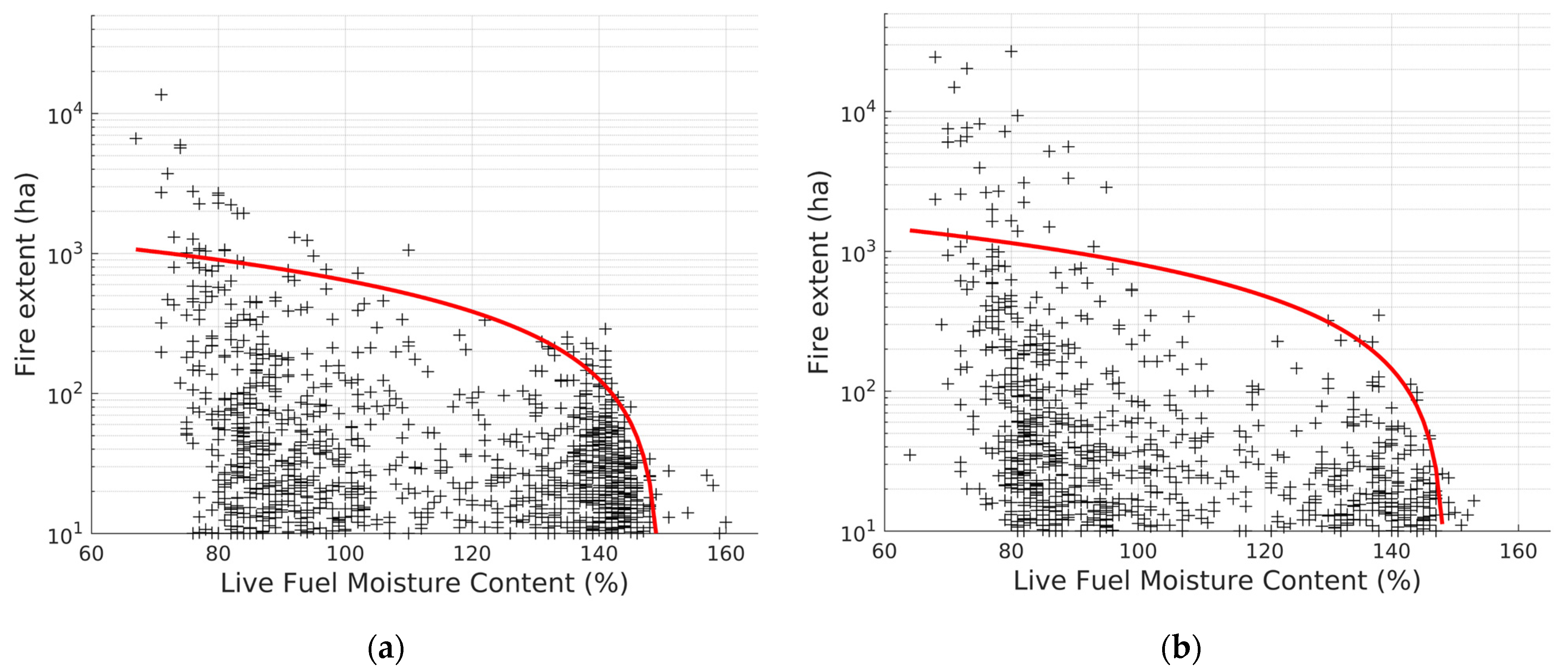

References
- Bradstock, R.A. A biogeographic model of fire regimes in Australia: Current and future implications. Glob. Ecol. Biogeogr. 2010, 19, 145–158. [Google Scholar] [CrossRef]
- Jolly, W.M. Sensitivity of a surface fire spread model and associated fire behaviour fuel models to changes in live fuel moisture. Int. J. Wildland Fire 2007, 16, 503–509. [Google Scholar] [CrossRef]
- Nelson, R.M. Water relations of forest fuels. In Forest Fires: Behavior and Ecological Effects; Johnson, E.A., Miyanishi, K., Eds.; Academic Press: San Diego, CA, USA, 2001; pp. 79–149. [Google Scholar]
- Jolly, W.M.; Johnson, D.M. Pyro-ecophysiology: Shifting the paradigm of live wildland fuel research. Fire 2018, 1, 8. [Google Scholar] [CrossRef]
- Rodrigues, M.; de Dios, V.R.; Sil, Â.; Camprubí, A.C.; Fernandes, P.M. VPD-based models of dead fine fuel moisture provide best estimates in a global dataset. Agric. For. Meteorol. 2024, 346, 109868. [Google Scholar] [CrossRef]
- Jurdao, S.; Chuvieco, E.; Arevalillo, J.M. Modelling fire ignition probability from satellite estimates of live fuel moisture content. Fire Ecol. 2012, 8, 77–97. [Google Scholar] [CrossRef]
- Viegas, D.X.; Viegas, M.; Ferreira, A.D. Moisture content of fine forest fuels and fire occurrence in central Portugal. Int. J. Wildland Fire 1992, 2, 69–86. [Google Scholar] [CrossRef]
- Rossa, C.G. The effect of fuel moisture content on the spread rate of forest fires in the absence of wind or slope. Int. J. Wildland Fire 2017, 26, 24. [Google Scholar] [CrossRef]
- Pimont, F.; Ruffault, J.; Martin-StPaul, N.K.; Dupuy, J.L. Why is the effect of live fuel moisture content on fire rate of spread underestimated in field experiments in shrublands? Int. J. Wildland Fire 2019, 28, 127–137. [Google Scholar] [CrossRef]
- Dennison, P.E.; Moritz, M.A. Critical live fuel moisture in chaparral ecosystems: A threshold for fire activity and its relationship to antecedent precipitation. Int. J. Wildland Fire 2009, 18, 1021–1027. [Google Scholar] [CrossRef]
- Nolan, R.H.; Boer, M.M.; Resco de Dios, V.; Caccamo, G.; Bradstock, R.A. Large-scale, dynamic transformations in fuel moisture drive wildfire activity across southeastern Australia. Geophys. Res. Lett. 2016, 43, 4229–4238. [Google Scholar] [CrossRef]
- Luo, K.; Quan, X.; He, B.; Yebra, M. Effects of live fuel moisture content on wildfire occurrence in fire-prone regions over southwest China. Forests 2019, 10, 887. [Google Scholar] [CrossRef]
- Jolly, W.M.; Freeborn, P.H.; Bradshaw, L.S.; Wallace, J.; Brittain, S. Modernizing the US National Fire Danger Rating System (version 4): Simplified fuel models and improved live and dead fuel moisture calculations. Environ. Model. Softw. 2024, 181, 106181. [Google Scholar] [CrossRef]
- Alexander, M.E.; Cruz, M.G. Assessing the effect of foliar moisture content on the spread rate of crown fires. Int. J. Wildland Fire 2013, 22, 415–427. [Google Scholar] [CrossRef]
- Anderson, W.R.; Cruz, M.G.; Fernandes, P.M.; McCaw, L.; Vega, J.A.; Bradstock, R.A.; Fogarty, L.; Gould, J.; McCarthy, G.; Marsden-Smedley, J.B.; et al. A generic, empirical-based model for predicting rate of fire spread in shrublands. Int. J. Wildland Fire 2015, 24, 443–460. [Google Scholar] [CrossRef]
- Marino, E.; Dupuy, J.L.; Pimont, F.; Guijarro, M.; Hernando, C.; Linn, R. Fuel bulk density and fuel moisture content effect on fire rate of spread: A comparison between FIRETEC model predictions and experimental results in shrub fuels. J. Fire Sci. 2012, 30, 277–299. [Google Scholar] [CrossRef]
- Rossa, C.G.; Fernandes, P.M. Live fuel moisture content: The ‘pea under the mattress’ of fire spread rate modeling? Fire 2018, 1, 43. [Google Scholar] [CrossRef]
- Yebra, M.; Dennison, P.E.; Chuvieco, E.; Riaño, D.; Zylstra, P.; Hunt, E.R., Jr.; Jurdao, S. A global review of remote sensing of live fuel moisture content for fire danger assessment: Moving towards operational products. Remote Sens. Environ. 2013, 136, 455–468. [Google Scholar] [CrossRef]
- van Wagner, C.E.; Stocks, B.J.; Lawson, B.D.; Alexander, M.E.; Lynham, T.J.; McAlpine, R.S. Development and Structure of the Canadian Forest Fire Behavior Prediction System; Fire Danger Group, Forestry Canada: Ottawa, ON, Canada, 1992. [Google Scholar]
- Finney, M.A. FARSITE, Fire Area Simulator—Model Development and Evaluation (No. 4); U.S. Department of Agriculture, Forest Service, Rocky Mountain Research Station: Fort Collins, CO, USA, 1998.
- Rothermel, R.C. A Mathematical Model for Predicting Fire Spread in Wildland Fuels; Intermountain Forest & Range Experiment Station, Forest Service, U.S. Department of Agriculture: Fort Collins, CO, USA, 1972; Volume 115. [Google Scholar]
- Rossa, C.G.; Fernandes, P.M. Empirical modeling of fire spread rate in no-wind and no-slope conditions. For. Sci. 2018, 64, 358–370. [Google Scholar] [CrossRef]
- Matthews, S. Effect of drying temperature on fuel moisture content measurements. Int. J. Wildland Fire 2010, 19, 800–802. [Google Scholar] [CrossRef]
- Rossa, C.G.; Fernandes, P.M.; Pinto, A. Measuring foliar moisture content with a moisture analyzer. Can. J. For. Res. 2015, 45, 776–781. [Google Scholar] [CrossRef]
- Caccamo, G.; Chisholm, L.A.; Bradstock, R.A.; Puotinen, M.L.; Pippen, B.G. Monitoring live fuel moisture content of heathland, shrubland and sclerophyll forest in south-eastern Australia using MODIS data. Int. J. Wildland Fire 2011, 21, 257–269. [Google Scholar] [CrossRef]
- Pellizzaro, G.; Cesaraccio, C.; Duce, P.; Ventura, A.; Zara, P. Relationships between seasonal patterns of live fuel moisture and meteorological drought indices for mediterranean shrubland species. Int. J. Wildland Fire 2007, 16, 232–241. [Google Scholar] [CrossRef]
- Vinodkumar, V.; Dharssi, I.; Yebra, M.; Fox-Hughes, P. Continental-scale prediction of live fuel moisture content using soil moisture information. Agric. For. Meteorol. 2021, 307, 108503. [Google Scholar] [CrossRef]
- Marino, E.; Yebra, M.; Guillén-Climent, M.; Algeet, N.; Tomé, J.L.; Madrigal, J.; Guijarro, M.; Hernando, C. Investigating live fuel moisture content estimation in fire-prone shrubland from remote sensing using empirical modelling and RTM simulations. Remote Sens. 2020, 12, 2251. [Google Scholar] [CrossRef]
- Costa-Saura, J.M.; Balaguer-Beser, Á.; Ruiz, L.A.; Pardo-Pascual, J.E.; Soriano-Sancho, J.L. Empirical models for spatio-temporal live fuel moisture content estimation in mixed Mediterranean vegetation areas using Sentinel-2 indices and meteorological data. Remote Sens. 2021, 13, 3726. [Google Scholar] [CrossRef]
- Cunill Camprubi, A.; González-Moreno, P.; Resco de Dios, V. Live fuel moisture content mapping in the Mediterranean Basin using random forests and combining MODIS spectral and thermal data. Remote Sens. 2022, 14, 3162. [Google Scholar] [CrossRef]
- Xie, J.; Qi, T.; Hu, W.; Huang, H.; Chen, B.; Zhang, J. Retrieval of live fuel moisture content based on multi-source remote sensing data and ensemble deep learning model. Remote Sens. 2022, 14, 4378. [Google Scholar] [CrossRef]
- Yebra, M.; Quan, X.; Riaño, D.; Larraondo, P.R.; Dijk, A.I.J.M.V.; Cary, G.J. A fuel moisture content and flammability monitoring methodology for continental Australia based on optical remote sensing. Remote Sens. Environ. 2018, 212, 260–272. [Google Scholar] [CrossRef]
- Lai, G.; Quan, X.; Yebra, M.; He, B. Model-driven estimation of closed and open shrublands live fuel moisture content. GIScience Remote Sens. 2022, 59, 1837–1856. [Google Scholar] [CrossRef]
- Quan, X.; Yebra, M.; Riaño, D.; He, B.; Lai, G.; Liu, X. Global fuel moisture content mapping from MODIS. Int. J. Appl. Earth Obs. Geoinf. 2021, 101, 102354. [Google Scholar] [CrossRef]
- Zhu, L.; Webb, G.I.; Yebra, M.; Scortechini, G.; Miller, L.; Petitjean, F. Live fuel moisture content estimation from MODIS: A deep learning approach. ISPRS J. Photogramm. Remote Sens. 2021, 179, 81–91. [Google Scholar] [CrossRef]
- Tanase, M.A.; Nova, J.P.G.; Marino, E.; Aponte, C.; Tomé, J.L.; Yáñez, L.; Madrigal, J.; Guijarro, M.; Hernando, C. Characterizing live fuel moisture content from active and passive sensors in a Mediterranean environment. Forests 2022, 13, 1846. [Google Scholar] [CrossRef]
- Gorelick, N.; Hancher, M.; Dixon, M.; Ilyushchenko, S.; Thau, D.; Moore, R. Google Earth Engine: Planetary-scale geospatial analysis for everyone. Remote Sens. Environ. 2017, 202, 18–27. [Google Scholar] [CrossRef]
- Schaaf, C.; Wang, Z. MCD43A4 MODIS/Terra+ Aqua BRDF/Albedo Nadir BRDF-Adjusted Ref Daily L3 Global 500m V006. NASA EOSDIS L. Process. DAAC; United States Geological Survey: Sioux Falls, SD, USA, 2015.
- Wan, Z.; Zhang, Y.; Zhang, Q.; Li, Z. Validation of the land-surface temperature products retrieved from Terra Moderate Resolution Imaging Spectroradiometer data. Remote Sens. Environ. 2015, 83, 163–180. [Google Scholar] [CrossRef]
- Carroll, M.L.; Townshend, J.R.G.; Hansen, M.C.; DiMiceli, C.M.; Huang, R.A.; Townshend, C. User guide for the MODIS Vegetation Continuous Fields Product, Collection 6, Version 1. 2017. Available online: https://lpdaac.usgs.gov/sites/default/files/public/product_documentation/mod44b_user_guide_v6.pdf (accessed on 1 March 2024).
- Buchhorn, M.; Smets, B.; Bertels, L.; Lesiv, M.; Tsendbazar, N.-E.; Herold, M.; Fritz, S. Copernicus Global Land Service: Land Cover 100m: Collection 3: Epoch 2019: Globe; Zenodo: Geneva, Switzerland, 2020. [Google Scholar] [CrossRef]
- Farr, T.G.; Rosen, P.A.; Caro, E.; Crippen, R.; Duren, R.; Hensley, S.; Alsdorf, D. The Shuttle Radar Topography Mission. Rev. Geophys. 2007, 45, RG2004. [Google Scholar] [CrossRef]
- Theobald, D.M.; Harrison-Atlas, D.; Monahan, W.B.; Albano, C.M. Ecologically-relevant maps of landforms and physiographic diversity for climate adaptation planning. PLoS ONE 2015, 10, e0143619. [Google Scholar] [CrossRef]
- Van Wagner, C.E. Development and Structure of the Canadian Forest Fire Weather Index System; Forestry Canadian Forestry Service: Ottawa, ON, USA, 1987. [Google Scholar]
- Instituto Português do Mar e da Atmosfera (IPMA). Nota Metodológica para o Cálculo do Índice de Risco de Incêndio Rural. 2020. [Online]. Available online: http://www.ipma.pt (accessed on 1 March 2024).
- Breiman, L. Random forests. Mach. Learn. 2001, 45, 5–32. [Google Scholar] [CrossRef]
- Kuhn, M.; Johnson, K. Applied Predictive Modeling; Springer: Berlin/Heidelberg, Germany, 2013. [Google Scholar]
- Krstajic, D.; Buturovic, L.J.; Leahy, D.E.; Thomas, S. Cross-validation pitfalls when selecting and assessing regression and classification models. J. Cheminform. 2014, 6, 10. [Google Scholar] [CrossRef]
- Meyer, H.; Reudenbach, C.; Hengl, T.; Katurji, M.; Nauss, T. Improving performance of spatio-temporal machine learning models using forward feature selection and target-oriented validation. Environ. Model. Softw. 2018, 101, 1–9. [Google Scholar] [CrossRef]
- Guyon, I.; Elisseeff, A. An introduction to variable and feature selection. J. Mach. Learn. Res. 2003, 3, 1157–1182. [Google Scholar]
- Li, X.; Zhang, Y.; Wang, Z. A comparative analysis of resampling methods in remote sensing. Remote Sens. 2022, 14, 456. [Google Scholar]
- Direção Geral do Território. Portuguese Land Cover and Land Use Map for 2018. Available online: https://www.dgterritorio.gov.pt/Carta-de-Uso-e-Ocupacao-do-Solo-para-2018 (accessed on 5 January 2025).
- Sá, A.C.L.; Benali, A.; Aparicio, B.A.; Bruni, C.; Mota, C.; Pereira, J.M.C.; Fernandes, P.M. A method to produce a flexible and customized fuel models dataset. MethodsX 2023, 10, 102218. [Google Scholar] [CrossRef] [PubMed]
- Benali, A.; Guiomar, N.; Gonçalves, H.; Mota, B.; Silva, F.; Fernandes, P.M.; Sá, A.C. The Portuguese Large Wildfire Spread Database (PT-FireSprd). Earth Syst. Sci. Data 2023, 15, 3791–3818. [Google Scholar] [CrossRef]
- Pereira, J.M.C.; Silva, P.C.; Melo, I.; Oom, D.; Baldassarre, G.; Pereira, M.G. Cartografia de Regimes de Fogo à Escala da Freguesia (1980–2017). ForestWISE (Coord.)-Projetos AGIF 2021 (P32100231), Vila Real, 2022; 38p. Available online: https://www.agif.pt/app/uploads/2022/05/Relat%C3%B3rio-Regimes-do-Fogo-%C3%A0-escala-da-freguesia-1980_2017_FW_vs_final.pdf (accessed on 5 January 2025).
- Matlab Central–Quanreg. Available online: https://www.mathworks.com/matlabcentral/fileexchange/32115-quantreg-x-y-tau-order-nboot (accessed on 5 January 2025).
- Instituto Português do Mar e da Atmosfera (IPMA). The Climate of Mainland Portugal. Available online: https://www.ipma.pt/pt/educativa/tempo.clima/ (accessed on 5 January 2025).
- Ruffault, J.; Martin-StPaul, N.; Pimont, F.; Dupuy, J.L. How well do meteorological drought indices predict live fuel moisture content (LFMC)? An assessment for wildfire research and operations in Mediterranean ecosystems. Agric. For. Meteorol. 2018, 262, 391–401. [Google Scholar] [CrossRef]
- McNorton, J.R.; Di Giuseppe, F. A global fuel characteristic model and dataset for wildfire prediction. Biogeosciences 2024, 21, 279–300. [Google Scholar] [CrossRef]
- Rao, K.; Williams, A.P.; Flefil, J.F.; Konings, A.G. SAR-enhanced mapping of live fuel moisture content. Remote Sens. Environ. 2020, 245, 111797. [Google Scholar] [CrossRef]
- Davim, D.A.; Rossa, C.G.; Pereira, J.M.; Guiomar, N.; Fernandes, P.M. The effectiveness of past wildfire at limiting reburning is short-lived in a Mediterranean humid climate. Fire Ecol. 2023, 19, 66. [Google Scholar] [CrossRef]
- Calheiros, T.; Nunes, J.P.; Pereira, M.G. Recent evolution of spatial and temporal patterns of burnt areas and fire weather risk in the Iberian Peninsula. Agric. For. Meteorol. 2020, 287, 107923. [Google Scholar] [CrossRef]
- Brown, T.P.; Hoylman, Z.H.; Conrad, E.; Holden, Z.; Jencso, K.; Jolly, W.M. Decoupling between soil moisture and biomass drives seasonal variations in live fuel moisture across co-occurring plant functional types. Fire Ecol. 2022, 18, 14. [Google Scholar] [CrossRef]
- Plucinski, M.P.; Anderson, W.R.; Bradstock, R.A.; Gill, A.M. The initiation of fire spread in shrubland fuels recreated in the laboratory. Int. J. Wildland Fire 2010, 19, 512–520. [Google Scholar] [CrossRef]
- Rossa, C.G.; Fernandes, P.M. On the effect of live fuel moisture content on fire-spread rate. For. Syst. 2017, 26, 12. [Google Scholar]
- Muñoz-Sabater, J.; Dutra, E.; Agustí-Panareda, A.; Albergel, C.; Arduini, G.; Balsamo, G.; Boussetta, S.; Choulga, M.; Harrigan, S.; Hersbach, H.; et al. ERA5-Land: A state-of-the-art global reanalysis dataset for land applications. Earth Syst. Sci. Data 2021, 13, 4349–4383. [Google Scholar] [CrossRef]
- Trigo, I.F.; DaCamara, C.C.; Viterbo, P.; Roujean, J.-L.; Olesen, F.; Barroso, C.; Camacho-de Coca, F.; Carrer, D.; Freitas, S.C.; García-Haro, J.; et al. The Satellite Application Facility on Land Surface Analysis. Int. J. Remote Sens. 2011, 32, 2725–2744. [Google Scholar] [CrossRef]
- Yebra, M.; van Dijk, A.; Cary, G.J. Evaluation of the Feasibility and Benefits of Operational Use of Alternative Satellite Data in the Australian Flammability Monitoring System to Ensure Long-Term Data Continuity; Bushfire and Natural Hazards CRC: Melbourne, Australia, 2018. [Google Scholar]

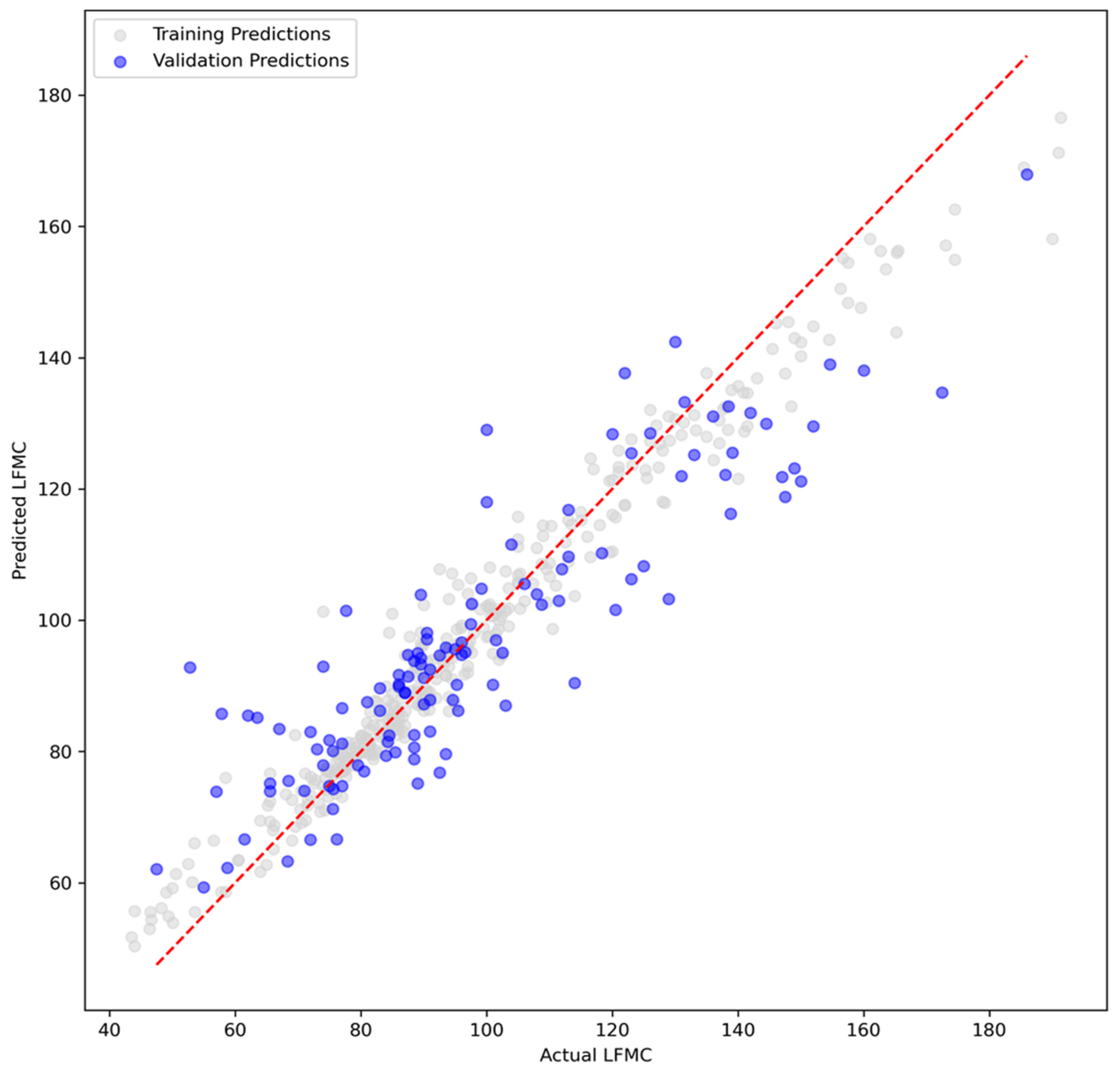
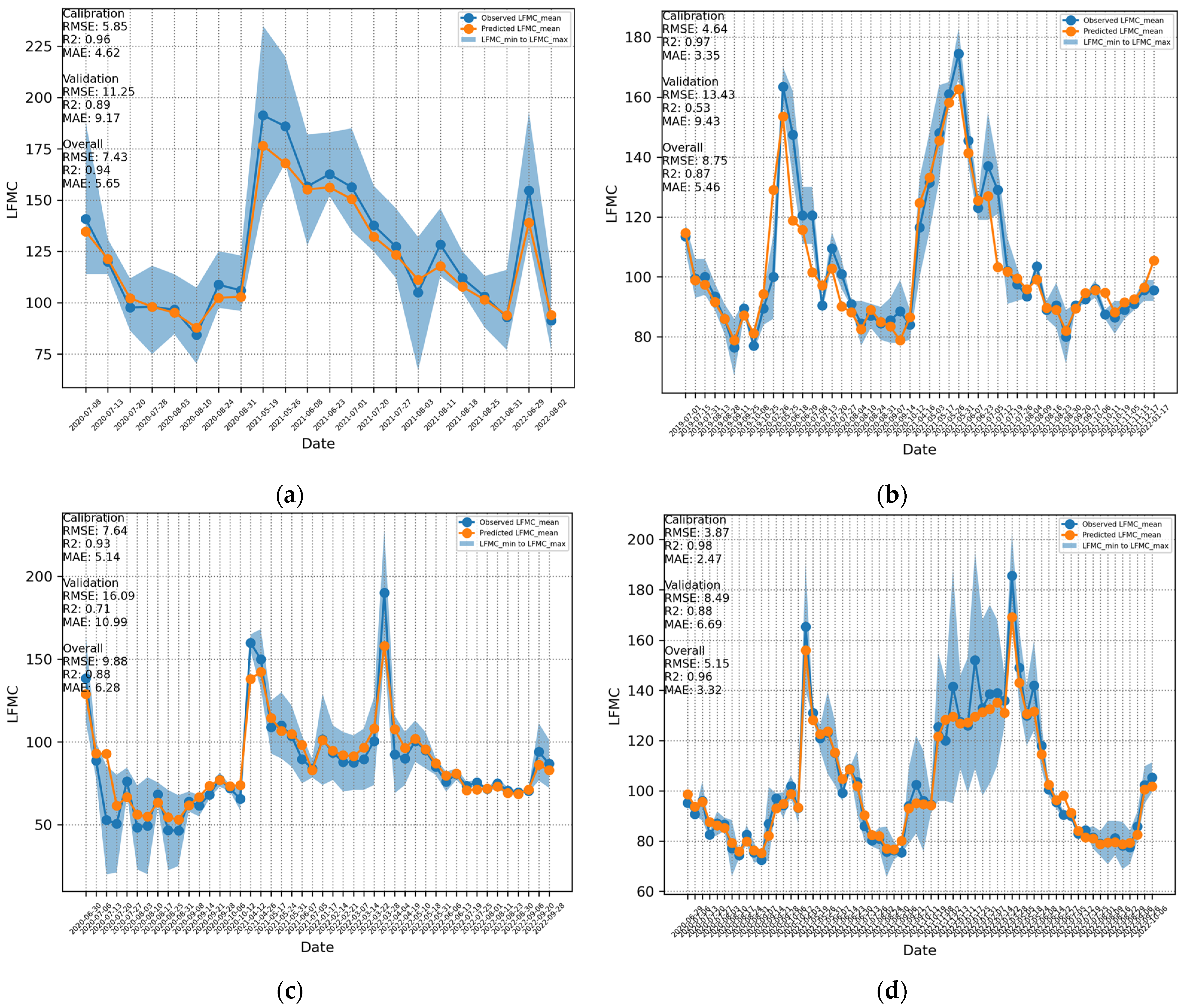


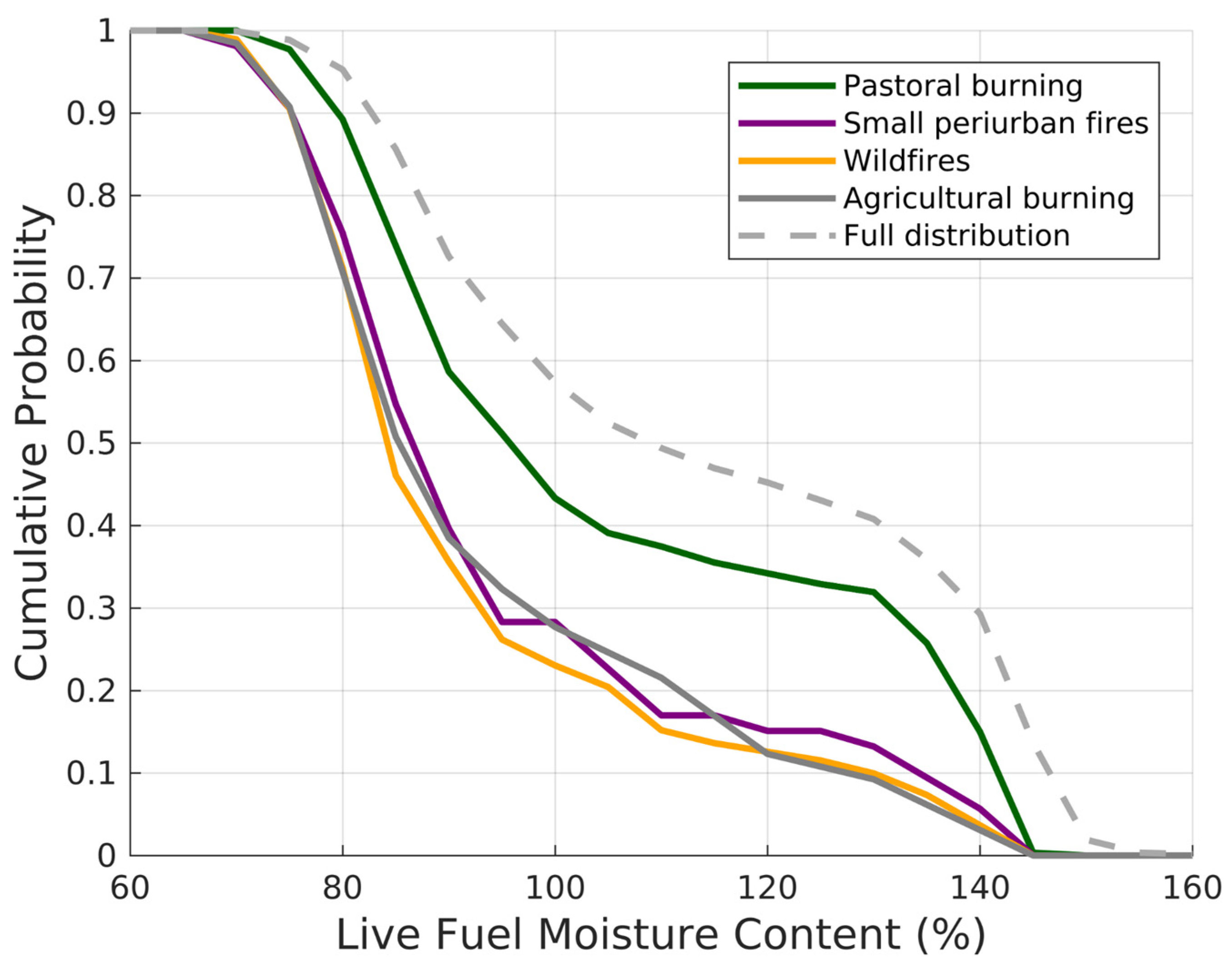

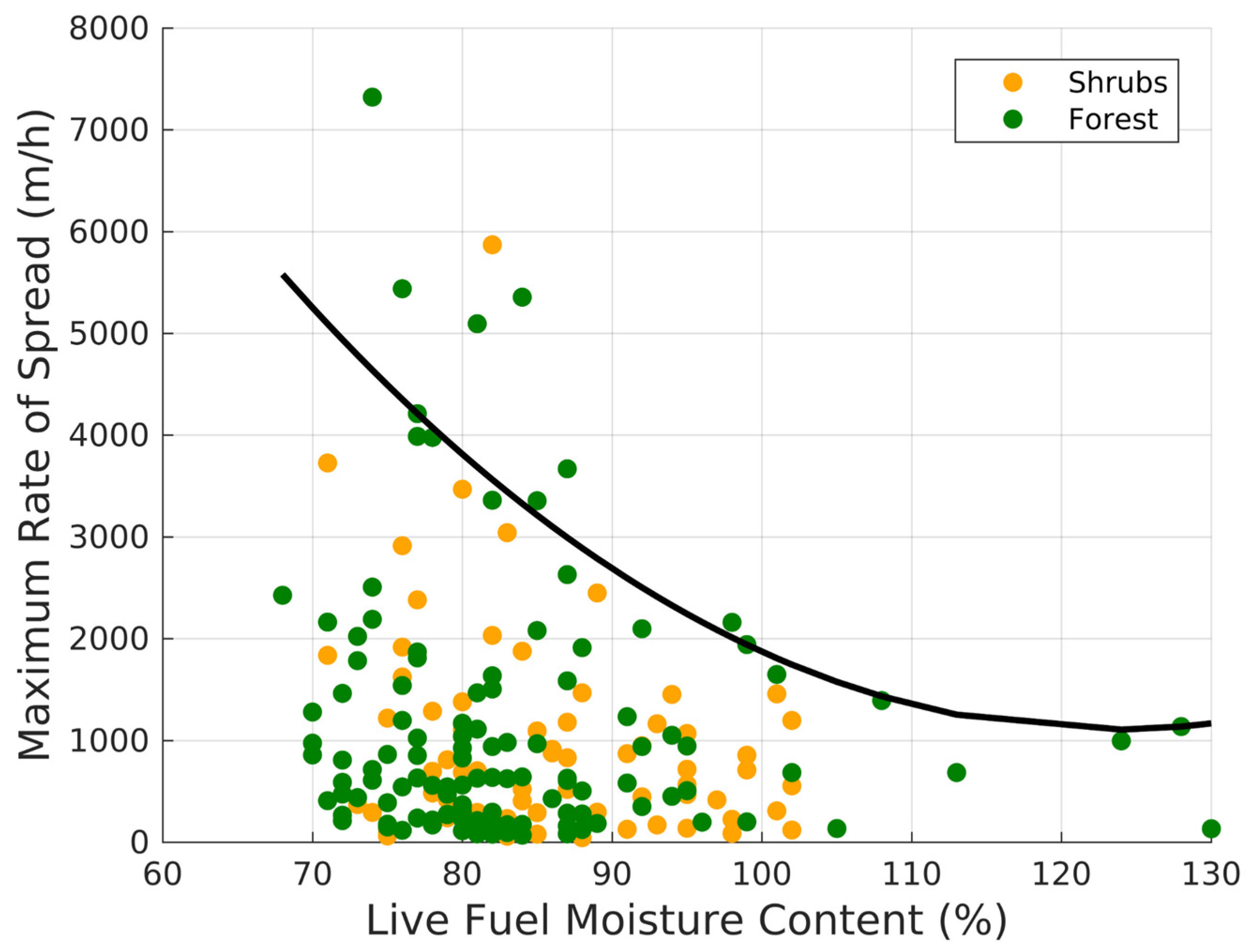
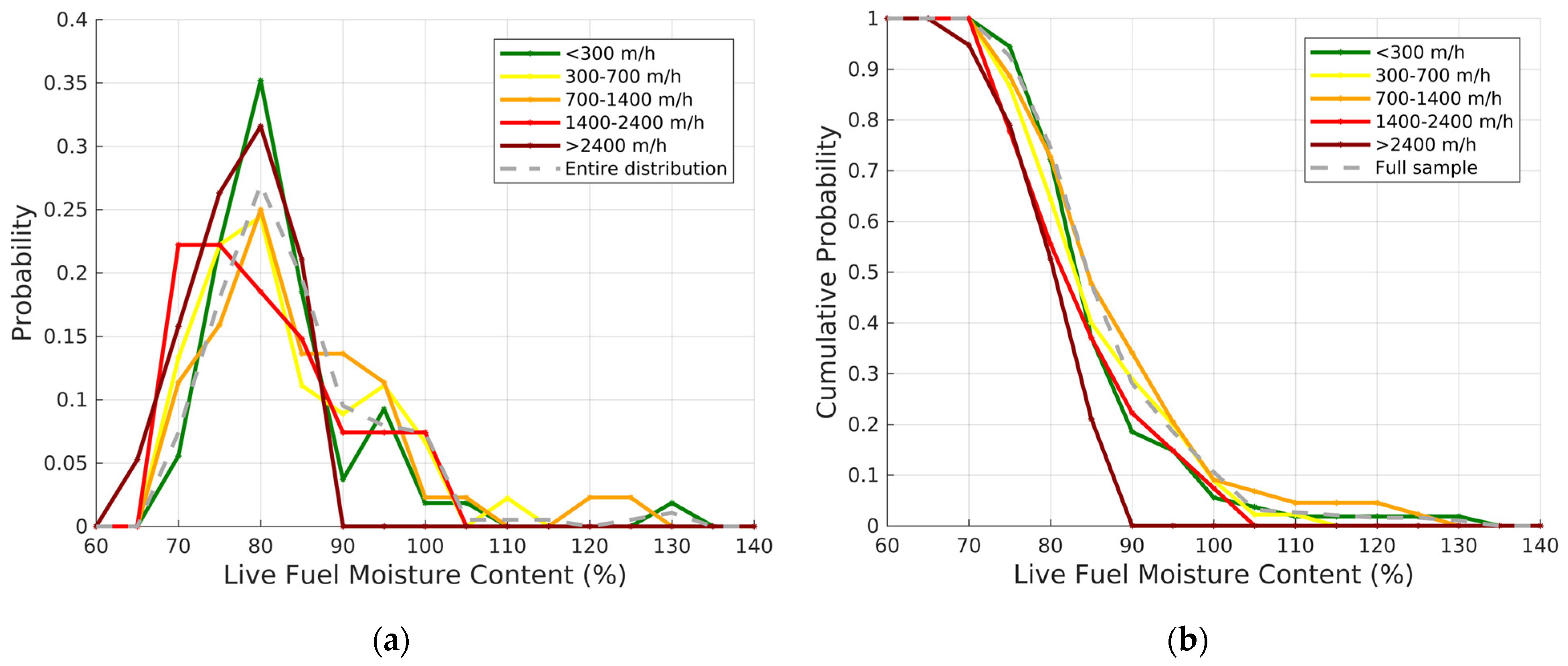
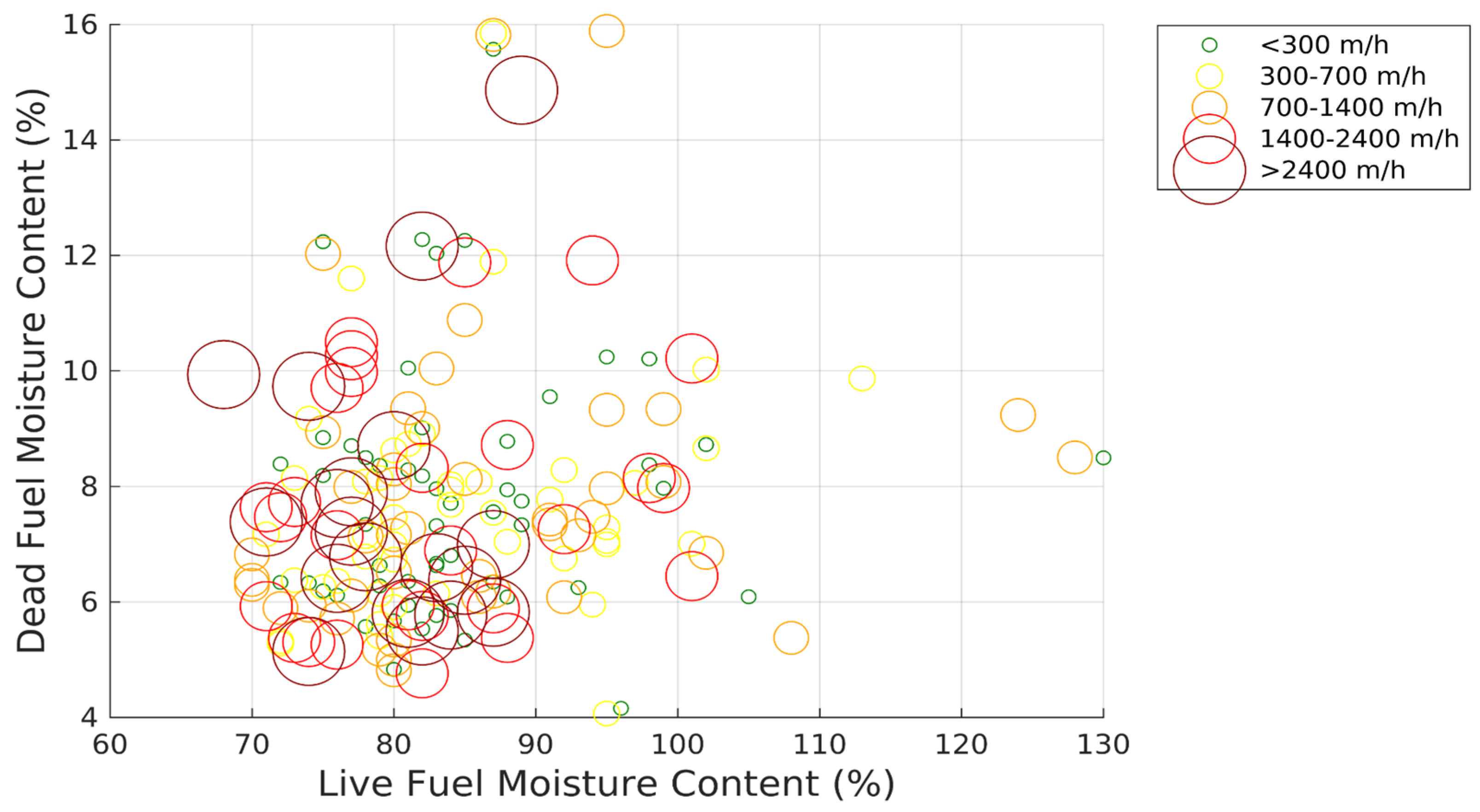
| ID | Location Name | Sampled Species | Sample Size | Period |
|---|---|---|---|---|
| 1 | Anelhe—Chaves | Pterospartum tridentatum, Erica sp. | 36 | 2020–2022 |
| 2 | Arrábida—Setúbal | Quercus coccifera, Cistus ladanifer | 46 | 2020–2022 |
| 4 | Chamusca | Cistus ladanifer, Ulex europaeus | 35 | 2020–2022 |
| 5 | Felgueira—Vale de Cambra | Pterospartum tridentatum, Ulex europaeus, Erica sp. | 23 | 2020–2022 |
| 6 | França—Bragança | Cistus ladanifer, Ulex europaeus | 24 | 2020–2022 |
| 7 | Granja—Castro Daire | Pterospartum tridentatum, Erica sp. | 37 | 2019–2022 |
| 9 | Lamares—Vila Real | Pterospartum tridentatum | 50 | 2019–2021 |
| 10 | Lamares—Vila Real (new) | Pterospartum tridentatum | 14 | 2022 |
| 11 | Monsanto—Lisboa | Quercus coccifera | 12 | 2020 |
| 12 | Oleirinhos—Bragança | Cistus ladanifer, Ulex europaeus | 8 | 2019 |
| 13 | Olelas | Cistus ladanifer | 44 | 2019–2022 |
| 14 | Ouressa—Sintra | Ulex europaeus, Erica sp. | 19 | 2020–2021 |
| 15 | Ponte de Lima | Ulex europaeus, Citysus sp. | 6 | 2019 |
| 16 | S. Penha—Portalegre | Ulex europaeus, Citysus sp. | 64 | 2020–2022 |
| 17 | Santarém | Ulex europaeus | 40 | 2019–2022 |
| 18 | Vile—Caminha | Pterospartum tridentatum, Ulex europaeus, Erica sp. | 19 | 2020–2021 |
| Vegetation Index | Formula |
|---|---|
| Normalized Difference Vegetation Index | NDVI = (B2 − B1)/(B2 + B1) |
| Normalized Difference Water Index | NDWI = (B2 − B5)/(B2 + B5) |
| Normalized Difference Infrared Index (band 6) | NDII6 = (B2 − B6)/(B2 + B6) |
| Normalized Difference Infrared Index (band 7) | NDII7 = (B2 − B7)/(B2 + B7) |
| Global Vegetation Moisture Index | GVMI = ((B2 + 0.1) − (B6 + 0.02))/((B2 + 0.1) + (B6 + 0.02)) |
| Enhanced Vegetation Index | EVI = 2.5 × ((B2 − B1)/(B2 + 6 × B1 − 7.5 × B3 + 1)) |
| Soil Adjusted Vegetation Index | SAVI = (1 + 0.5) × ((B2 − B1)/(B2 + B1 + 0.5)) |
| Visible Atmospherically Resistant Index | VARI = (B4 − B1)/(B4 + B1 − B3) |
| Vegetation Index—Green | VI green = (B4 − B1)/(B4 + B1) |
| Normalized Difference Tillage Index | NDTI = (B6 − B7)/(B6 + B7) |
| Simple Tillage Index | STI = B6/B7 |
| Moisture Stress Index | MSI = B6/B2 |
| Greenness index | Gratio = B4/B1 |
| Variables and Product | Temporal Resolution | Spatial Resolution (m) | Availability Range | Temporal Averaging (Days Before) | Normalization |
|---|---|---|---|---|---|
| Nadir Reflectance Band 1 to Band 7 (MCD43A4.061) | Daily | 500 | 2000–present | 30, 60, 80 | - |
| Vegetation Indices 1 | Daily | 500 | 2000–present | 30, 60, 80 | Yes |
| Land Surface Temperature (MOD11A2.061) | 8-day | 1000 | 2000–present | 30, 60, 80 | Yes |
| Elevation, Slope, Aspect (NASA SRTM) | Static | 30 | 2000 | - | - |
| Landform (Global ALOS Landforms) | Static | 90 | 2006 | - | - |
| Percent Non-Vegetated, Tree Cover and Non-Tree Vegetation (MOD44B.006) | Annual | 250 | 2000–2020 | - | - |
| Various cover fractions 2 (CGLS-LC100 Coll.3) | Annual | 250 | 2015–2019 | - | - |
| Fire Weather Index and sub-indices 3 | Daily | 1000 | 2018–present | - | Yes |
| Day of Year (Sine and Cosine) and Day Length | - | - | - | - | - |
| ID | Location Name | Sample Size | RMSE (%) | R2 |
|---|---|---|---|---|
| 1 | Anelhe—Chaves | 36 | 14.65 (10.30) | 0.61 (0.71) |
| 2 | Arrábida—Setúbal | 46 | 16.09 (9.88) | 0.71 (0.88) |
| 4 | Chamusca | 35 | 16.43 (9.73) | 0.63 (0.87) |
| 5 | Felgueira—Vale de Cambra | 23 | 11.25 (7.43) | 0.89 (0.94) |
| 6 | França—Bragança | 24 | 12.23 (10.45) | 0.59 (0.88) |
| 7 | Granja—Castro Daire | 37 | 11.64 (7.69) | 0.77 (0.88) |
| 9 | Lamares—Vila Real | 50 | 13.43 (8.75) | 0.53 (0.87) |
| 10 | Lamares—Vila Real (new) | 14 | 14.84 (9.70) | 0.80 (0.83) |
| 11 | Monsanto—Lisboa | 12 | 3.06 (1.93) | 0.47 (0.58) |
| 12 | Oleirinhos—Bragança | 8 | 12.43 (6.17) | 0.48 (0.91) |
| 13 | Olelas | 44 | 11.63 (6.59) | 0.72 (0.90) |
| 14 | Ouressa—Sintra | 19 | 11.06 (7.52) | 0.86 (0.97) |
| 15 | Ponte de Lima | 6 | NA 1 | NA 1 |
| 16 | S. Penha—Portalegre | 64 | 8.49 (5.15) | 0.88 (0.96) |
| 17 | Santarém | 40 | 4.95 (8.03) | 0.86 (0.91) |
| 18 | Vile—Caminha | 19 | 4.83 (3.59) | NA 1 (0.93) |
Disclaimer/Publisher’s Note: The statements, opinions and data contained in all publications are solely those of the individual author(s) and contributor(s) and not of MDPI and/or the editor(s). MDPI and/or the editor(s) disclaim responsibility for any injury to people or property resulting from any ideas, methods, instructions or products referred to in the content. |
© 2025 by the authors. Licensee MDPI, Basel, Switzerland. This article is an open access article distributed under the terms and conditions of the Creative Commons Attribution (CC BY) license (https://creativecommons.org/licenses/by/4.0/).
Share and Cite
Benali, A.; Baldassarre, G.; Loureiro, C.; Briquemont, F.; Fernandes, P.M.; Rossa, C.; Figueira, R. A Near-Real-Time Operational Live Fuel Moisture Content (LFMC) Product to Support Decision-Making at the National Level. Fire 2025, 8, 178. https://doi.org/10.3390/fire8050178
Benali A, Baldassarre G, Loureiro C, Briquemont F, Fernandes PM, Rossa C, Figueira R. A Near-Real-Time Operational Live Fuel Moisture Content (LFMC) Product to Support Decision-Making at the National Level. Fire. 2025; 8(5):178. https://doi.org/10.3390/fire8050178
Chicago/Turabian StyleBenali, Akli, Giuseppe Baldassarre, Carlos Loureiro, Florian Briquemont, Paulo M. Fernandes, Carlos Rossa, and Rui Figueira. 2025. "A Near-Real-Time Operational Live Fuel Moisture Content (LFMC) Product to Support Decision-Making at the National Level" Fire 8, no. 5: 178. https://doi.org/10.3390/fire8050178
APA StyleBenali, A., Baldassarre, G., Loureiro, C., Briquemont, F., Fernandes, P. M., Rossa, C., & Figueira, R. (2025). A Near-Real-Time Operational Live Fuel Moisture Content (LFMC) Product to Support Decision-Making at the National Level. Fire, 8(5), 178. https://doi.org/10.3390/fire8050178








